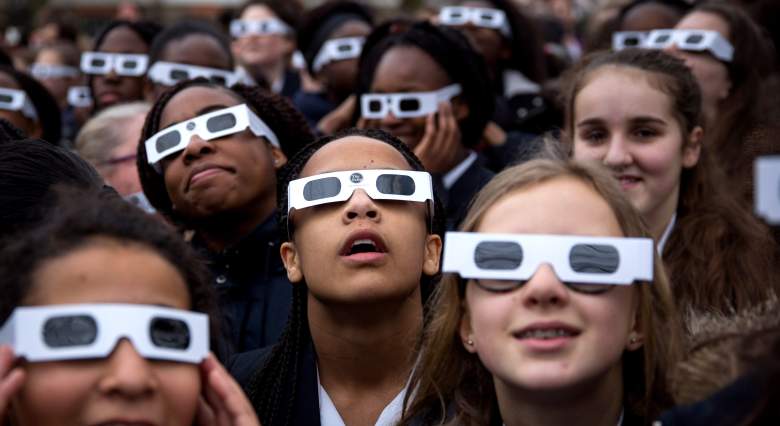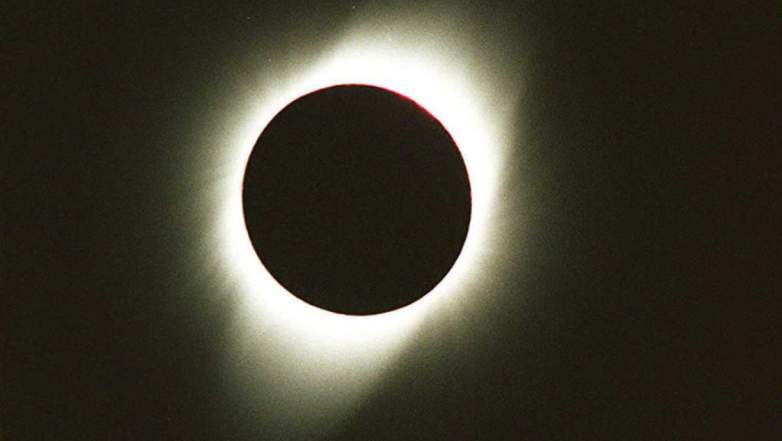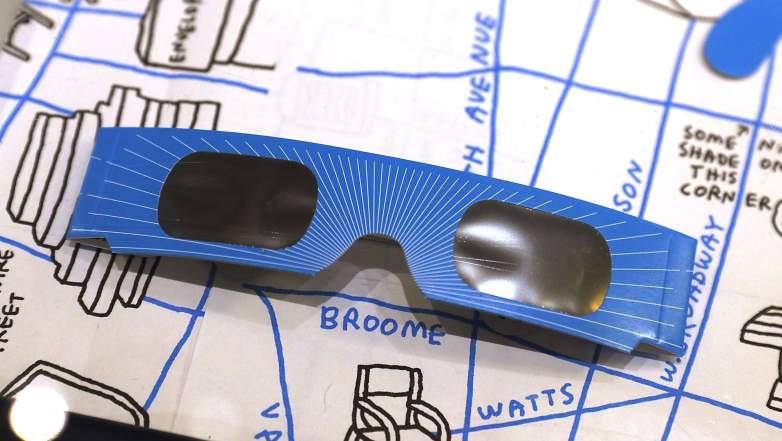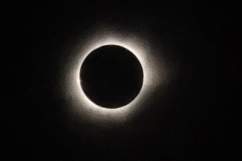
Getty
The 2017 solar eclipse arrives on August 21. If you live in Canada, is it possible to still get solar eclipse glasses? Can you see the solar eclipse?
Several U.S. states will see a total eclipse, which means the sun will be completely blocked by the moon. That doesn’t mean that Canadians won’t get a spectacular view of their own. They will. “Canadians will see a partial eclipse, with the western coast seeing the most dramatic coverage of the sun,” reports Global News.ca.
As for solar eclipse glasses, they are getting hard to find (see below for some ideas), but you’re lucky because there are official viewing parties all over Canada that will provide you with a safe glimpse.
The best perch in Canada to see the solar eclipse? According to Global News.ca, “Canadians in Victoria will see as much as 91 per cent of the sun go dark, giving them the best view in the country, according to the Royal Astronomical Society of Canada (RASC). Vancouver residents are close behind at 88 per cent.”

GettyThe view of a total solar eclipse in 1995.
A lot of retailers are selling out of solar eclipse glasses. You could try buying them online (on sites like Kijiji, Craigslist or eBay) if you can get them in time, but then you have to worry about fakes. Toronto Sun reminds you, “You need to wear special glasses called solar filters that meet a worldwide ISO standard: specifically ISO 12312-2.”
You could try a DIY project (suggestions provided below). One of your best bets in Canada, though, are Royal Astronomical Society of Canada Viewing Areas. “Across all of Canada, we will see the Moon cover up a portion of the Sun – a partial eclipse. WARNING- never look at the Sun without proper protection. Use properly made solar viewers such as the ones for sale on the RASC estore. These filters are safe to look through with your eyes only (not to be used with other optical devices such as binoculars or telescopes – just your eyes,” the Society says on a web page devoted to the solar eclipse. “Members of the Royal Astronomical Society of Canada plan to set up telescopes on eclipse day to show the various phases of the partial eclipse through telescopes equipped with filters to allow safe viewing.”
This page has a list of those viewing areas.
Where can you get solar eclipse glasses?
Retailers
Retailers across Canada were selling solar eclipse glasses. Some outlets that were selling the glasses are Best Buy and Toys ‘R’ Us. However, reports CBC, “supplies had dwindled in stores across Canada. Inventory status reports on the websites for Best Buy and Toys “R” Us showed the devices, which cost about $3, were sold out in many cities.” Call your local store in case you luck out, but don’t count on getting solar eclipse glasses this way anymore.
London Drugs is also selling solar eclipse glasses. “…the chain sold thousands of pairs and B.C.’s Lower Mainland and Saskatchewan were the first to sell out,” reports CBC.
At this point, retailers may not be your best option.
Online
Amazon is still selling the glasses. Your problem, though, will be getting them in time, which is unlikely at this point. In addition, due to the problem with fakes, Amazon has issued refunds to customers and safety warnings.
EBay, Kijiji, and Craigslist are better choices, if you can pick them up directly from the seller in your hometown (but, as always, take safety precautions and only meet strangers in public areas with other people around.) Here’s where you can find Canadian Craigslist sites. Just click on your community, if it’s listed, and type in “solar eclipse glasses” in the search box. We did so and found them available in many places. There have been a lot of news reports about people charging high prices for the glasses on these sites, but we found them also offered pretty cheaply.
Here’s the catch, though, and it’s a big one: There have been problems with unsafe, fake solar eclipse glasses flooding the market. It’s critically important that you only use certified glasses. Looking at a solar eclipse without proper eyewear can seriously damage your vision. One other option is to make a DIY project for solar eclipse viewing. See below for some options there.
You can start with getting recent glasses that were sold at a retailer on the American Astronomical Society list of reputable vendors (although be aware that people can fake such things.) We know that’s American, not Canadian, but when you are purchasing online, products often cross the border.

GettyA pair of free solar eclipse glasses sit on display.
Writes NASA of the AAS list: “Refer to the American Astronomical Society (AAS) Reputable Vendors of Solar Filters & Viewers … for a list of manufacturers and authorized dealers of eclipse glasses and handheld solar viewers verified to be compliant with the ISO 12312-2 international safety standard for such products.”
Why not just go straight to one of those retailers and skip eBay or Craigslist? You could try, but probably won’t have much luck at this stage. The American Astronomical Society does say on its website that most of the retailers on its list are sold out. Retailers on the American Astronomical Society’s list of approved retailers are Love’s Travel Stops, 7-Eleven are “Bi-Mart, Casey’s General Store, Hobby Town, Kirklands, London Drugs [sold out], Lowe’s, Maverik, McDonald’s (Oregon only), Pilot/Flying J, Toys “R” Us [sold out], and Walmart.” The page also has a list of other online vendors you could try, but at this point getting the glasses shipped to you in time can be tricky. Some online vendors currently advertising overnight shipping report they are sold out of the product once you go to their websites.
Here is how to check if solar eclipse glasses are, in fact, certified. NASA refers people to the American Astronomical Society, which has been working rigorously to help people spot uncertified fakes. The site recommends, “How do you know if your eclipse glasses or handheld solar viewers are truly safe? You need to know that they meet the ISO 12312-2 (sometimes written as ISO 12312-2:2015) international safety standard. Filters that are ISO 12312-2 compliant not only reduce visible sunlight to safe and comfortable levels but also block solar UV and IR radiation.” However, the issue is that some people copy the codes and fake it.
According to AAS, that’s why it developed the list of reputable vendors and retailers. “We’ve checked manufacturers’ ISO paperwork to make sure it’s complete and that it comes from a recognized, accredited testing facility, and we’ve personally examined manufacturers’ products. We’ve asked manufacturers to identify their authorized resellers, and we’ve asked dealers to identify the source of the products they’re selling. Only when everything checks out do we add a vendor to our listing,” the site explains. “If we don’t list a supplier, that doesn’t mean their products are unsafe — only that we have no knowledge of them or that we haven’t convinced ourselves they are safe.” (But, yes, that gets you back to the problem of so many glasses being sold out.)
There are some other clues as to whether the glasses are good, but you need to get them first to know. “How can you tell if your solar viewer is not safe? You shouldn’t be able to see anything through a safe solar filter except the Sun itself or something comparably bright, such as the Sun reflected in a mirror, a sunglint off shiny metal, the hot filament of an unfrosted incandescent light bulb, a bright halogen light bulb, a bright-white LED bulb (including the flashlight on your smartphone), a bare compact fluorescent (CFL) bulb, or an arc-welding torch. All such sources (except perhaps the welding torch) should appear quite dim through a solar viewer. If you can see shaded lamps or other common household light fixtures (not bare bulbs) of more ordinary brightness through your eclipse glasses or handheld viewer, and you’re not sure the product came from a reputable vendor, it’s no good,” AAS explains.
DIY Projects
There are a lot of fun DIY projects you can make for solar eclipse viewing that don’t require you to dangerously look directly into the sun. One of the easiest and most common is called a solar eclipse box, viewer, or pinhole projector. According to Boy’s Life, “This type of viewer is also known as a pinhole projection because the image of the eclipse is projected through the pinhole onto the viewing surface. You will be looking at a projection of the eclipse instead of looking directly at the sun.”
Learn how to make them here (with videos):
